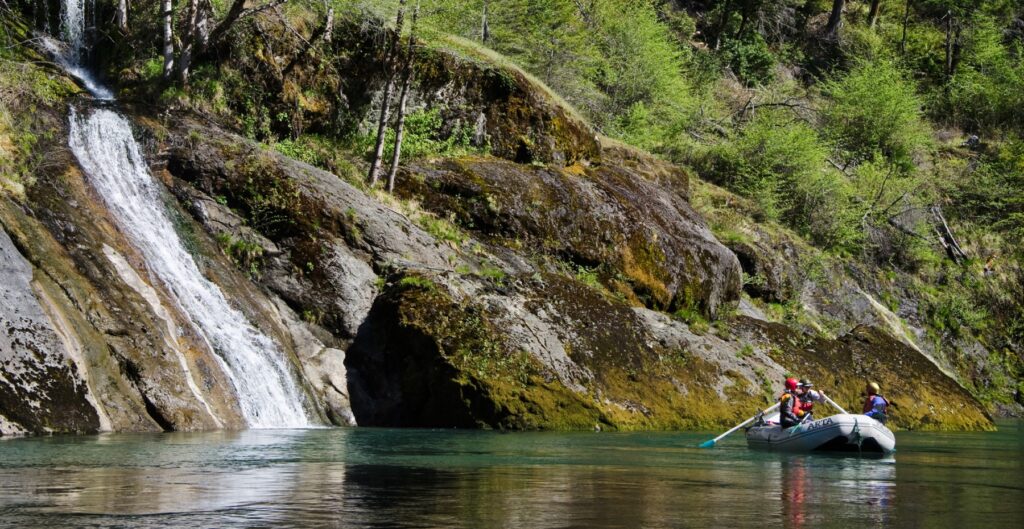
Snowpacks and their Impact on Rafting Western Rivers
A big snowpack like this year across most of the Western United States generates excitement among both rafters and winter sports enthusiasts. The accumulated layers of snow in mountainous regions play a crucial role in determining water levels and flow rates for our favorite rafting rivers.
In this article, we will explore how snowpacks impact rafting experiences, with a focus on differentiating between dam-release and free-flowing rivers and their tributaries. Additionally, we will delve into specific Western rivers, highlighting their unique characteristics, including the Rogue, Middle Fork Salmon, Main Salmon, Lodore Canyon, Yampa River, Cataract Canyon, Grand Canyon, and Tuolumne.
Snowpacks and Water Supply
Snowpacks act as natural reservoirs, storing water during the winter months and gradually releasing it as snow melts in spring and summer. The rate and timing of this snowmelt directly impact river levels and flows. Unlike their Eastern counterparts, which rely more on rainfall, western rivers heavily depend on snowpacks for their water supply. This makes snow accumulation and subsequent melt an essential component of their ecosystems. Over the last couple of decades the west has been seeing smaller snowpacks which is why there is considered a long-term drought affecting rafting.

Links to Current Snowpack Reports
Free-Flowing Rivers and Their Tributaries
Free-flowing rivers are those that are not significantly regulated by dams or diversions. These rivers reflect the natural hydrological patterns dictated by snowpack conditions. The Yampa River, located in a remote wilderness, exemplifies the impact of snowpacks on a free-flowing river. The Yampa River’s peak flows typically occurring in early June. During years with a large snowpack in the Rockies, high water runoff creates thrilling rapids not seen during normal or low water years.
The Middle Fork Salmon and Main Salmon Rivers in Idaho are also free-flowing rivers influenced by snowpacks. Flowing through the rugged and picturesque Salmon River Mountains, their water levels rise during the peak snowmelt season, usually in June. The snowpacks in these regions determine the intensity and navigability of the rapids, making it essential for outfitters to consider the snowpack conditions when planning their trips. During times of the year when flows get too high or too low trips will bypass the upper 20 miles on the Middle Fork.

Dam-Release Rivers and Their Impacts
On the otherhand, government agencies regulate flows on Dam-release rivers. These rivers are subject to water releases scheduled to meet various demands, such as irrigation, power generation, and water supply. While snowpacks still influence the overall water supply in dam-release rivers, human management often mitigates or modifies the natural flows.
Lodore Canyon in Colorado, situated in Dinosaur National Monument, offers thrilling rapids on the Green River. Upstream Flaming Gorge Dam regulates the water flows in Lodore Canyon. Water releases from the dam typically accommodate recreational activities like rafting, providing consistent flows throughout the season. This ensures an optimal rafting experience despite variations in snowpack conditions.
The Rogue River in Southern Oregon, with its thrilling rapids and stunning scenery, is also a dam-release river. Water released from Lost Creek Dam meets downstream flow requirements and recreational needs, creating consistent conditions for rafting enthusiasts throughout the season.

Iconic Western Rivers: A Combination of Flow Types
When considering snowpacks and their impact on rafting, it is important to note that some Western rivers encompass both dam-release sections and free-flowing tributaries. One such example is Cataract Canyon, a destination for high water rafting enthusiasts. While the Colorado River within the Grand Canyon experiences regulated flows due to upstream dams on the Green River and in Colorado, other tributaries, such as the Yampa River, flow freely and are directly influenced by snowpack conditions.
Rafting Cataract Canyon offers a unique blend of dam-regulation that allows for late season run and spring time high water creating a diverse and dynamic experience before the river flows into Lake Powell which controls and provides consistent year-round flows on the Colorado River through Grand Canyon.

The Tuolumne River in California’s Sierra Nevada is another example of a river system affected by both dam releases and free-flowing tributaries. The Hetch Hetchy Reservoir, regulated by the O’Shaughnessy Dam, plays a role in water management and releases. However, the Tuolumne River also receives contributions from snowmelt and free-flowing tributaries, such as the Clavey River and South Fork of the Tuolumne River, which can influence the overall rafting conditions. During years with a large snowpack, Hetch Hetchy will fill and spill meaning that the Tuolumne downstream will flow much like a free-flowing river since the reservoir is just passing water through rather than holding back some of the water flowing into it.
Adapting to Changing Conditions
It is crucial to understand that snowpack conditions can vary from year to year due to weather patterns including the amount of precipitation, when it was deposited, how early the mountains start to warm-up and how hot it gets. While some years may see abundant snow accumulation and higher water levels, others may experience lower snowpacks, resulting in reduced river flows.
Snowpack conditions vary from year to year due to weather patterns, including the amount of precipitation, the timing of its deposition, how early the mountains start to warm up, and the maximum daily temperatures. While some years may see abundant snow accumulation and higher water levels, others may experience lower snowpacks, resulting in reduced river flows.
Rafting companies, park authorities, and local water management organizations play a vital role in providing updates and information about snowpack levels, scheduled releases and river conditions to help enthusiasts make informed decisions about their trips.
Concluding thoughts on Snowpacks
Snowpacks exert a significant influence on the rafting experiences offered by Western rivers. Whether it’s the free-flowing rivers like the Rogue, Middle Fork Salmon, and Main Salmon, or the combination of dam-release sections and free-flowing tributaries found in the Grand Canyon, Tuolumne, and Cherry Creek, understanding the impact of snowpacks helps for planning the right rafting adventures. So, whether you seek heart-pumping rapids or serene wilderness, remember to embrace the influence of snowpacks when embarking on your next rafting journey one of the stunning Western rivers.
Start Planning Your Best Adventure
Dispatches from adventure tours around the world and tips for intrepid travelers. Read Our Blog
Are Federal Cuts Affecting Whitewater Rafting Trips?
We understand that recent news about federal workforce reductions may raise questions about outdoor recreation on public lands. However, we want to reassure our guests that all of our whitewater rafting trips are operating as planned.
Keep Reading > Are Federal Cuts Affecting Whitewater Rafting Trips?
Tips for Planning Group Rafting Trips
Rafting with a group of friends can be a fun, memorable experience, but organizing can be a daunting task. Below is a guide to the process of organizing a trip as well as some tips to help you avoid the difficulties and minimize the challenges of planning a group rafting trip. Read about the different types of group trips.
Cherry Creek and Tuolumne River Flows
For those planning trips, we’ve provided estimated current flows and historical flows for the past five years at two key locations: Meral’s Pool (for Tuolumne River trips) and Mushroom Rapid (for Cherry Creek runs).







